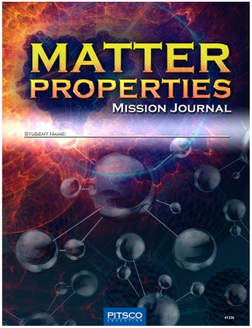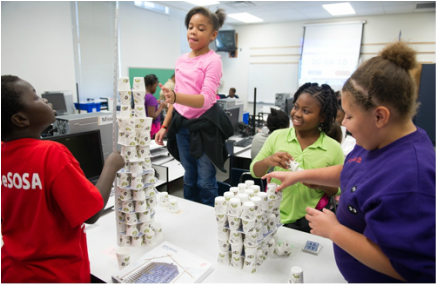 Reading. One of the key indicators of academic excellence starts when a child opens a book. Reading helps with basic speech skills, better communication skills, helps a student master the language, and creates more logical thinking skills. Students who read have better concentration skills, and exhibit more discipline in academic life. It’s no wonder schools focus so heavily on this crucial skill at an early age. Pitsco Education understands the importance of reading, and have built in strong reading components to the redesigned elementary coursework. Within the Pitsco Education Missions, students are asked to do many different activities that incorporate reading and literacy. Students have to read aloud, complete reading comprehension activities, speak and listen within their team, acquire new vocabulary, and use their writing skills. Almost daily in their Missions, students are asked to read and gather information from informational texts (nonfiction books). With the advent of the national ELA standards, literacy is significantly emphasized. The reading required of students in the Missions helps address these standards. READING IN MISSIONS Briefings
WRITING IN MISSIONS Mission Journals
SPEAKING AND LISTENING IN MISSIONS Collaboration
LANGUAGE IN MISSIONS Vocabulary words
Not bad for a STEM curriculum, right? Adding the R (Reading) and A (Arts) elements pay off for elementary students, both know and later in their academic careers. The interdisciplinary nature of the Missions allows for the reinforcement and application of reading, writing, and literacy within the teaching of science curriculum. The Pitsco Missions provide cross-curricular connections and makes the R in STREAM an integral part in the student experience. Blog adapted from the Pitsco Network Magazine, content by Tammy Pankey. See original article here.
1 Comment
 “What do you want to be when you grow up?” This is a favorite question for relatives to ask students at the holiday dinner table. It’s a great question – it help Aunt Sue understand which classes a student enjoys, and prompts the student to think about and articulate their plans for the future. While students are accustomed to sharing career aspirations about jobs they are familiar with – “doctor” “firefighter” and “construction worker” -- students in Pitsco Expeditions labs may have new answers this year. That is because Pitsco is weaving in Career Connections into every Expedition, giving students exposure to exciting careers, and a context for the skills they are learning. Introducing Junior High students to careers like Product Designers, Entrepreneurs, Materials Tester, Crime Lab Specialist, Chemists, and Architects serves a couple of purposes: Understanding the “Real World” When a student starts to think about what they can do after graduation, they start to look at the world around them in a different way – they look through an empowered lens with confidence. They begin to understand the role each career can play in the world around them, and how they would improve that career. Adds Relevance to Current Lessons When they can add relevance to an abstract concept, like why understanding math and simple circuits is a building block for a future in electronics or electrical engineering, they start to take the lesson more seriously. Students go from rote memorization to truly understanding a concept and how it applies outside of the classroom. Explore Aptitude Students, especially at the middle level, learn so much about themselves through trial and error. Having a hand and “trying out” careers like “Concert Lighting Technicians” broadens their mindset, and helps them consider career paths they may not have previously considered. Let’s face it, we are educating students for careers that haven’t even been invented yet, so building a solid skills foundation, as well as a broad scope is important. Transcends Economic Factors Often, a student’s socio-economic background has an effect on the careers they are exposed to. Career connections play an invaluable role in expanding a student’s horizons. Expeditions by Pitsco Education aim to expand and draw career connections for students. Click below for a complete list of career connections by Expedition. You tell us: why are Career Connections so important to middle level students? How do you introduce your students to potential career paths?  An avid fan of STEM, makerspaces, and project-based learning, Aaron Maurer shares his journey from humble beginnings to becoming a district level leader and champion for STEM Education. In this presentation, Aaron offers the audience tips and tricks, funding ideas, and potential pitfalls to look out for when creating your own STEM program. Aaron has been in education for more than a decade teaching a variety of subjects and grade levels. Currently, he is an instructional coach for Bettendorf Middle School and mentors three robotics teams. Aaron recently launched a new engineering program called Young Engineers of Today and is a member of the Microsoft Innovator Educator Expert program. He was a finalist for the Iowa Teacher of the Year in 2014. You can find all of his work on his website, http://www.coffeeforthebrain.com/. Watch the recorded webinar (above) and let us know what you think!  At Pitsco, they have always understood that the teachers are the experts. Classroom teachers are their greatest resource as they develop and refine curriculum. They use professional development site visits, surveys and forums to determine what is working well in the classroom, and what they could improve upon. When asked, Missions teachers responded with feedback. And Pitsco listened…. And developed Missions 2.0, which will be launched in 2017. When updating, Pitsco focused on three areas of improvement:
Are you ready to add STEM to your Elementary curriculum? Contact Moss to learn more about Missions from Pitsco.
Despite their tuxedoed appearance, penguins aren’t always well mannered. In the aftermath of one particular penguin scuffle among endangered African Penguins at Mystic Aquarium, Yellow/Purple (AKA “Purps”) was found to have a nonfunctional flexor tendon in her ankle. Much like an injury to a person’s Achilles heel, damage to a penguin’s flexor tendon leads to pain and difficulty in motion. Once Purps’ injury was identified, the veterinary staff at Mystic Aquarium took action with a handmade boot to immobilize, protect and support the damaged foot. Yet the animal care team knew more modern solutions were available that would not only be more durable and less cumbersome for the small bird, but also require less time than handcrafting the boot. Mystic Aquarium’s Chief Clinical Veterinarian, Dr. Jen Flower, proposed 3D printing. Blog courtesy of 3D Systems.
Hands-on activities are important for every class, but paramount for science classes. The biggest challenge teachers have in incorporating class activities is the amount of set up time it takes to prepare for class. Labs can take up to 90 minutes – each day – to set up, which is costly for teachers.
Labdisc makes it possible to incorporate hands-on instruction while saving teachers in set up time without sacrificing quality instruction. The Labdisc is the only all-in-one wireless laboratory which teachers can apply in instruction. An all-in-one science lab in the palm of your hand, Labdisc is an important classroom tool:
Labdisc can integrate technology into science class with this affordable solution, and replaces science-class consumables with one easy-to-use tool.  Myra Hudson was doing a fine job teaching science in her fifth-grade classroom at Miller Park Elementary School in Omaha, Nebraska. With nearly 15 years of teaching experience, Hudson knew plenty about science, going all the way back to her days as a student in a traditional science lab. In fact, by all accounts, she was an above-average science teacher at the elementary level, where science often is viewed warily by teachers better versed in reading and math. The disruption for Hudson occurred late last school year when she was asked to implement a pilot program of Pitsco elementary science Missions. To say she was skeptical would be an understatement. To say she was eager for the change would be an overstatement. “The science lab I grew up with, there were sinks, Bunsen burners, no carpet, only wood,” said Hudson. “And then I got in here for the training, and I thought, ‘This doesn’t look like a science lab.’” Instead, there were seven four-student workstations with colorful bins of inviting, age-appropriate materials, uniquely laid-out binders with detailed information and assessments set up in “windows” and “intervals,” and a specific role for each member of the Crew: Commander, Information Specialist, Communications Specialist, and Materials Specialist. “Before the professional development, I thought, ‘I don’t see how this is going to tie in to our curriculum.’ I did the Forces Mission by myself because I wanted to see all four roles and how it would work so I could internalize it. It got to the point where it didn’t matter what I thought about it because it’s all about how the kids react to it,” Hudson said. “I thought, ‘Maybe I’m looking at this wrong because of the way I was taught.’ This is a science lab, and they do so much in here.” Read more of the Omaha Public Schools case study here. |
AuthorYou have questions about STEM education? You're not alone! We're here to share ideas and provide thought-provoking commentary. Let us know your thoughts! Sign Up for Email Updates For Email Marketing you can trust. Categories
All
Archives
February 2017
|
- Home
-
K-12
- College
- Industry
- Certifications
-
Partners
- Afinia-3D Printing
- Amatrol-Manufacturing Training Equipment
- Apolo Studios- Welding Simulation
- Bantam Tools - CNC
- CEF-Custom Educational Furniture
- DAC Worldwide-Manufacturing Training Equipment
- Greene Manufacturing Inc - Furniture
- Iconic CNC
- Interior Concepts-Furniture
- MSSC Certifications
- MINDS-i Education
- Pitsco Education-STEM
- SimLog-Heavy Equipment Simulation
- Stokes Robotics
- Techno CNC Systems
- Universal Laser Systems
- VictoryXR - Virtual Reality
- WB Mfg - Furniture
- Funding
- Contact
- About
- Home
-
K-12
- College
- Industry
- Certifications
-
Partners
- Afinia-3D Printing
- Amatrol-Manufacturing Training Equipment
- Apolo Studios- Welding Simulation
- Bantam Tools - CNC
- CEF-Custom Educational Furniture
- DAC Worldwide-Manufacturing Training Equipment
- Greene Manufacturing Inc - Furniture
- Iconic CNC
- Interior Concepts-Furniture
- MSSC Certifications
- MINDS-i Education
- Pitsco Education-STEM
- SimLog-Heavy Equipment Simulation
- Stokes Robotics
- Techno CNC Systems
- Universal Laser Systems
- VictoryXR - Virtual Reality
- WB Mfg - Furniture
- Funding
- Contact
- About

 RSS Feed
RSS Feed
